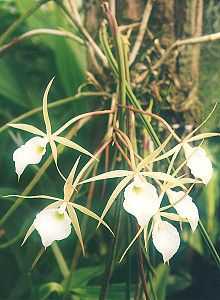Brassavola flagellaris
| Brassavola flagellaris | |
|---|---|
 | |
| Scientific classification | |
| Kingdom: | Plantae |
| (unranked): | Angiosperms |
| (unranked): | Monocots |
| Order: | Asparagales |
| Family: | Orchidaceae |
| Subfamily: | Epidendroideae |
| Tribe: | Epidendreae |
| Subtribe: | Laeliinae |
| Genus: | Brassavola |
| Section: | B. sect. Sessilabia |
| Species: | B. flagellaris |
| Binomial name | |
| Brassavola flagellaris Barb. Rodr. (1882) | |
Brassavola flagellaris Barb. Rodr. 1881 is a species of epiphytic orchid of the Cattleya alliance. It grows wild in eastern Brazil, where it fills the evening air with the citrus-like fragrance of its blossoms.
Etymology
The specific epithet, flagellaris refers to the elongated (whip-like) leaves. In Brazil, the common name is Munida de chicote, meaning "whip."
Description
B. flagellaris is a sympodial epiphyte (sometimes a lithophyte) with 6 – 30 cm long terete pseudobulbs, each carrying a single elongated succulent leaf. The erect or pendulous inflorescence carries one to several flowers bearing long and narrow light-green sepals which closely resemble the lateral petals. The broad white lip closely encircles most of the light yellow-green column.
Members of this species grow readily under cultivation and are resistant to drought. They can be placed on slabs to allow their roots sufficient aeration.
References
External links
| External identifiers for Brassavola flagellaris | |
|---|---|
| Also found in: Wikispecies |
| Wikimedia Commons has media related to Brassavola flagellaris. |